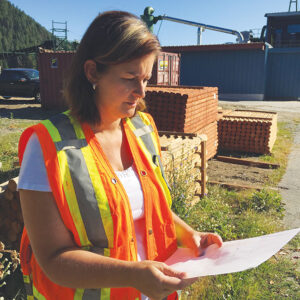
Features
High value: ATCO thrives through self-sufficiency and innovation
April 20, 2023 By Jennifer Ellson
 From its humble sawmilling roots, ATCO has evolved to a cutting-edge manufacturer of specialized softwood veneer and other wood products. Photo: Annex Business Media.
From its humble sawmilling roots, ATCO has evolved to a cutting-edge manufacturer of specialized softwood veneer and other wood products. Photo: Annex Business Media. Longevity. Resilience. Innovation. Survival.
There’s a family-owned business in the heart of B.C.’s West Kootenays that checks all those boxes.
ATCO Wood Products has evolved over the decades from its humble sawmilling roots to a cutting-edge manufacturer of specialized softwood veneer and other wood products.
Rebecca Weatherford is the third-generation owner and president of ATCO, in the picturesque village of Fruitvale. At the company’s helm as CEO is Rebecca’s husband, Scott Weatherford.
Three generations of success
ATCO’s story begins in 1923, when Rebecca’s grandfather, Atle Nelson, immigrated to Canada from Sweden. Coming from a sawmilling background, Atle immediately got involved in the local timber industry, eventually establishing his own sawmill with his sons in 1959, naming it ATCO Lumber ¬– a combination of ‘Atle’ and ‘company’.
In the early 1970s, Atle’s sons decided to add a factory that made softwood veneer using a rotary lathe. In 2002, ATCO officially exited the lumber business by closing the sawmill to focus exclusively on making softwood veneer and the associated products that come from that process.
Over the next years, ATCO would be passed on to Atle’s sons, from oldest to youngest, until 2007, when the youngest son Ted retired and sold the company to his daughter, Rebecca.
Coming from the hotel management sector in Washington state, Rebecca approached the new family venture cautiously. Scott was in the heavy equipment industry at the time and almost moved the family to Shanghai, China, for a job opportunity.
“But we decided to move to Fruitvale instead in 2007 to raise our kids and run the family business,” says Scott. They renamed it ATCO Wood Products.
A few years ago, while going through some old boxes in the office, Rebecca came across an old handwritten map that belonged to her grandfather Atle. Circled in red pen, and with her grandfather’s handwriting, were the words “good fir” on a part of the map. Rebecca said it was an area that Atle harvested in the late 1950s.
“I took my daughter on a hike to that very spot, and in that moment, I felt a deep connection to this company, the community, and my family’s heritage here,” Rebecca says.
Those trees are ready for harvest again, she says, and realizing that her 19-year-old daughter and 16-year-old son could have the same experience in 30 years is one reason why she loves the business.
Staying power
“For over 60 years, since my grandfather founded ATCO, we have grown, evolved and weathered the ups and downs of wood products markets,” explains Rebecca.
Canadian Forest Industries joined the Weatherfords and their team for a tour of the Fruitvale facility last year, where they shared the secret to the family venture’s longevity: never stop innovating and creating high-value specialized products.
“Our customers are shrinking due to consolidation. We ourselves survived decades of consolidation by specializing,” Scott explains.
Self-sufficiency is key
Self-sufficiency is also a huge factor, Scott adds, and ATCO achieves this by being fully integrated.
ATCO has a forest management arm that controls the two Crown forest tenures it owns in the Arrow Forest District and Kootenay Lake Forest District. ATCO also has several private land management contracts, and its location close to the Canada-U.S. border has proven to be beneficial as it is also involved in the timber market in nearby northern Washington State, in addition to southern B.C.
ATCO’s belief in being self-sufficient made it invest in a short-line railroad in 2011 as a vital part of their transportation strategy. It connects the ATCO mill to the Burlington Northern
Santa Fe network in the U.S. With the addition of a reload facility at Columbia Gardens in the nearby community of Trail, B.C., ATCO started loading lumber and other wood products from other mills in the area to get them to the U.S. Since it is an American line, there’s no need to change rail carriers.
“We add assets that make sense,” Scott says. “The railroad used to be a cost centre for us, but now with innovation and investment, it looks after its own costs and even generates some return.”
Part of being self-sufficient is also being able to do your own repairs and lately, even machine rebuilds.
“We are remotely located, so we built a machine shop onsite where we do our own repairs, or we contract locals to design and rebuild some equipment for us,” Scott explains, adding that his engineering background, combined with the deep talent at ATCO in fabrication, mechanical design and project management, are serving the company well.
“Being remote, we are prone to having supply chain issues, so we try to fabricate as much as we can onsite. In fact, we can venture into the equipment and heavy machinery business anytime,” he jokes.
Investing in the business and the community
ATCO employs 120 out of Fruitvale’s population of less than 2,000 people. It directly employs 70 and hires 50 full time contractors throughout mill maintenance, woodlands and rail operations. The plant produces some 125 MMsf (3/8-inch basis) of softwood veneer (8-foot and 10-foot veneer lengths in thicknesses ranging from 1/10 to 1/6) annually.
Cores left over once the veneer has been stripped from the logs are used for landscaping ties. They are shaved on the top and bottom and are sometimes stained per customers’ requests. Bark becomes high-grade ground cover. Logs that are not used are turned into firewood.
Wood chips go to Mercer’s Celgar mill in neighbouring Castlegar and to other regional pulp mills, while biomass goes to Avista Utilities, an electric and natural gas company in Kettle Falls, Wash., for production of green energy, as well as the local landscape market.
Timber – mostly Douglas fir, larch and spruce – are sourced from ATCO’s harvesting operations on Crown and private lands, open market timber purchases, as well as timber trading with other regional companies of harvested timber not used in their respective mills. ATCO works primarily with three logging contractors operating on their Crown and private land operations.
Once the logs are brought to the mill, the production flow start in the log yard equipped with a Cat 980H wheel loader. The logs then pass through a VK Kodiak double ring 36-inch debarker with a with Brunette Machinery drum chipper, and BM&M chip screen. Once the blocks are the correct length, they are fed into the peeler bins and go through the conditioning system comprising hot water chests and a Windsor steam chest.
After softening, blocks are sent to a Raute charger and then to a Premier Gear lathe with COE core drive and Elite Automation controls, followed by a Ventek GS2000 scanner that checks for defects prior to a clipper, a Ventek MPDS diverter, a Raute 4 bin full sheet stacker and an Acrowood veneer chipper with BM&M chip screen.
In recent years, ATCO completed investments in the facility’s conditioning systems and lathe upgrades. In fact, just before the COVID-19 pandemic disrupted the world, ATCO invested in a second veneer line: a spindleless lathe from a Chinese equipment supplier that the ATCO team redesigned and rebuilt onsite.
“The line has several improvements and modifications – designed, constructed and implemented in-house. Our style of innovation works for us – we have a good track record,” Scott says.
“We have a long history of reinvesting strategically in projects that will improve safety, productivity and quality or will introduce new products for us, and that has allowed us to remain competitive.”
Navigating turbulence
B.C.’s Premier David Eby said it himself: “The forest industry is in crisis.” The problem of the lack of economic fibre and other uncertainties have forced several mills to shut operations both temporarily and permanently. In fact, some mills in the West Kootenays have been affected.
“With the economic and wood product market uncertainty, we are spending more time developing our strategy and long-term capital plan and will be more focused on analyzing new capital deployment while wood products markets remain unsettled,” says Scott.
Rebecca agrees: “We maintain our passionate commitment to forest stewardship, and deep connection to our communities and employees. Wood is the most sustainable and environmentally friendly building product we can use, and its role in helping fight climate change makes me optimistic for the future of our industry.”
“Still, as more land in B.C. is set aside for non-forestry purposes, the shrinking timber harvesting land base is threatening the ability of small, family-owned forestry businesses to be viable for the next generation,” explains Rebecca.
“Innovation to create high-value wood products and increased utilization of the timber resource is the key to a strong future in our industry,” she says. “But we also need decision-makers in B.C. to be bold and courageous in their support of the forest industry to ensure that we have a working forest to provide timber for our family forestry companies to survive and continuing benefiting our communities and our environment.”
Print this page

